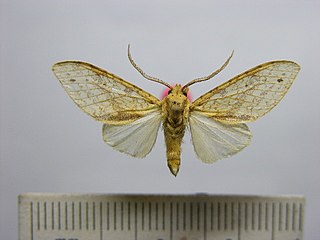
William Schaus was an American entomologist who became known for his major contribution to the knowledge and description of new species of the Neotropical Lepidoptera.

Lophocampa debilis is a moth of the family Erebidae. It was described by William Schaus in 1920. It is found in Mexico, Costa Rica and Guatemala.
Lophocampa dinora is a moth of the family Erebidae. It was described by William Schaus in 1924. It is found in Argentina and Bolivia.
Givira durangona is a moth in the family Cossidae described by William Schaus in 1901. It is found in Mexico (Durango) and the United States, where it has been recorded from Colorado.
Blepharomastix branealis is a moth in the family Crambidae. It was described by William Schaus in 1924. It is found in Jamaica.
Blepharomastix carthaghalis is a moth in the family Crambidae. It was described by William Schaus in 1924. It is found in Peru.
Blepharomastix cronanalis is a moth in the family Crambidae. It was described by William Schaus in 1924. It is found in Peru.
Blepharomastix styxalis is a moth in the family Crambidae. It was described by William Schaus in 1924. It is found in French Guiana.
Conchylodes nissenalis is a moth in the family Crambidae described by William Schaus in 1924. It is found in Peru.
Microphysetica ambialis is a moth in the family Crambidae. It was described by William Schaus in 1924. It is found in Mexico (Xalapa) and Guatemala.
Piletocera agathanalis is a moth in the family Crambidae. It was described by William Schaus in 1924. It is found in Panama.

Pilocrocis sororalis is a moth in the family Crambidae. It was described by William Schaus in 1920. It is found in Panama and Guatemala.
Polygrammodes dubialis is a moth in the family Crambidae. It was described by Schaus in 1924. It is found in Brazil.
Salbia midalis is a moth in the family Crambidae. It was described by William Schaus in 1924. It is found in Ecuador.
Steniodes dominicalis is a moth in the family Crambidae. It was described by Schaus in 1924. It is found on Dominica.
Steniodes nennuisalis is a moth in the family Crambidae. It was described by Schaus in 1924. It is found in Peru.
Sufetula grumalis is a moth in the family Crambidae. It was described by William Schaus in 1920. It is found in Cuba.
Syntrita nimalis is a moth in the family Crambidae. It was described by William Schaus in 1924. It is found in Bolivia.
Podalia schadei is a moth of the Megalopygidae family. It was described by William Schaus in 1924. It is found in Paraguay.

Dugonia is a monotypic genus of moths in the family Notodontidae, containing only the species Dugonia eliera. The genus and species were both first described in 1928 by William Schaus from an unspecified number of female specimens from the Dognin collection. It is known from French Guiana, with a type locality in Saint-Laurent-du-Maroni.



